Correlation between Apelin and Some Angiogenic Factors in the Pathogenesis of Preeclampsia: Apelin-13 as Novel Drug for Treating Preeclampsia and Its Physiological Effects on Placenta
- PMID: 34819954
- PMCID: PMC8608536
- DOI: 10.1155/2021/5017362
Correlation between Apelin and Some Angiogenic Factors in the Pathogenesis of Preeclampsia: Apelin-13 as Novel Drug for Treating Preeclampsia and Its Physiological Effects on Placenta
Abstract
Preeclampsia (PE) is one of the commonest causes for maternal and fetal morbidity and mortality. Imbalances of angiogenic factors, oxidative stress, and inflammatory response have a role in the pathogenesis of PE. Data regarding the circulating apelin level and its role in PE remains controversial. This study was formulated to assess the serum apelin level in PE, investigate its correlation with some inflammatory, oxidative stress, and angiogenic proteins in a nitric oxide synthase inhibitor; the N (gamma)-nitro-L-arginine methyl ester (L-NAME)-induced rat model of PE and determine whether apelin administration could protect against development of PE. 40 healthy adult female albino rats and 10 adult male albino rats were used in this study. The pregnant female rats were randomly divided into three groups: group 1 (normal pregnant group), group 2 (PE-induced group), injected subcutaneously with 75 mg L-NAME/kg bodyweight/day starting from day 9 to 20 of gestation, and group 3 (PE-induced group supplemented with apelin (PE + apelin)); PE induced as before and simultaneously subcutaneously injected with apelin-13 (6 × 10-8 mol/kg bodyweight/twice daily) beginning from day 6 to 20 of gestation. In all groups, blood pressure and urine protein were determined at gestation days (GD) 0, 10, and 18. Moreover, serum apelin, placental growth factor (PLGF), vascular endothelial growth factor (VEGF), soluble fms-like tyrosine kinase-1 (sFlt-1), soluble endoglin (sEng), interferon-gamma (IFN-γ), and interleukin-10 (IL-10) levels and serum superoxide dismutase enzyme (SOD) and catalase (CAT) activities of all groups were estimated at the end of experiment. Placental histopathological examination was also performed. PE-induced rats showed significantly decreased serum apelin levels. Moreover, they showed significantly increased blood pressures, urine proteins, sFlt-1, sEng, and IFN-γ (mean arterial blood pressure, urine proteins, sFlt-1, sEng, and IFN-γ showed significant negative correlations with serum apelin level), but it showed significantly decreased VEGF, PLGF, IL-10, SOD, and CAT (VEGF, PLGF, IL-10, and SOD showed significant positive correlations with serum apelin level). In contrast, exogenous apelin administration significantly ameliorated these parameters together with improvement in the placental histoarchitecture in the apelin-supplemented PE group. This study demonstrated the protective effects of apelin administration on the pathogenesis of PE.
Copyright © 2021 Reham Z. Hamza et al.
Conflict of interest statement
The authors declare that they have no conflicts of interest.
Figures




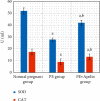
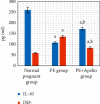


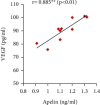

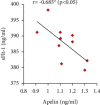
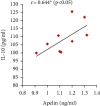

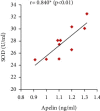
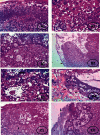
Similar articles
-
[Different effects of pravastatin on sFlt-1, PlGF and VEGF in different preeclampsia-like mouse models].Zhonghua Fu Chan Ke Za Zhi. 2019 Sep 25;54(9):601-607. doi: 10.3760/cma.j.issn.0529-567x.2019.09.005. Zhonghua Fu Chan Ke Za Zhi. 2019. PMID: 31550776 Chinese.
-
Ameliorative effect of apelin-13 against renal complications in L-NAME-induced preeclampsia in rats.PeerJ. 2021 Mar 31;9:e11110. doi: 10.7717/peerj.11110. eCollection 2021. PeerJ. 2021. PMID: 33850656 Free PMC article.
-
The relationship between circulating tissue transglutaminase, soluble fms-like tyrosine kinase-1, soluble endoglin and vascular endothelial growth factor in pre-eclampsia.J Hum Hypertens. 2016 Dec;30(12):788-793. doi: 10.1038/jhh.2016.32. Epub 2016 May 12. J Hum Hypertens. 2016. PMID: 27169826
-
Dysregulation of anti-angiogenic agents (sFlt-1, PLGF, and sEndoglin) in preeclampsia--a step forward but not the definitive answer.J Reprod Immunol. 2009 Nov;82(2):106-11. doi: 10.1016/j.jri.2009.09.001. Epub 2009 Oct 23. J Reprod Immunol. 2009. PMID: 19853925 Review.
-
Pathogenesis of Preeclampsia and Therapeutic Approaches Targeting the Placenta.Biomolecules. 2020 Jun 24;10(6):953. doi: 10.3390/biom10060953. Biomolecules. 2020. PMID: 32599856 Free PMC article. Review.
Cited by
-
Effects of apelin on neonatal brain neurogenesis in L-NAME-induced maternal preeclampsia.Sci Rep. 2024 Aug 20;14(1):19347. doi: 10.1038/s41598-024-69326-2. Sci Rep. 2024. PMID: 39164321 Free PMC article.
-
Coffee intake leads to preeclampsia-like syndromes in susceptible pregnant rats.J Nutr Sci. 2024 Sep 18;13:e34. doi: 10.1017/jns.2024.36. eCollection 2024. J Nutr Sci. 2024. PMID: 39314530 Free PMC article.
-
Is There a Correlation between Apelin and Insulin Concentrations in Early Second Trimester Amniotic Fluid with Fetal Growth Disorders?J Clin Med. 2023 Apr 28;12(9):3166. doi: 10.3390/jcm12093166. J Clin Med. 2023. PMID: 37176607 Free PMC article.
-
Targeting the apelin system for the treatment of cardiovascular diseases.Cardiovasc Res. 2023 Dec 30;119(17):2683-2696. doi: 10.1093/cvr/cvad171. Cardiovasc Res. 2023. PMID: 37956047 Free PMC article. Review.
-
A Comparison of Apelin Rs56204867 and Apelin Receptor Rs11544374 Gene Polymorphisms and Their Association with Risk of Preeclampsia in Southeast Iran.Rep Biochem Mol Biol. 2024 Jul;13(2):273-280. doi: 10.61186/rbmb.13.2.273. Rep Biochem Mol Biol. 2024. PMID: 39995647 Free PMC article.
References
-
- Farhood T. H., Ewadh M. J., Alshaik S. F. Reduced glutathione, lipid peroxidation and malondialdehyde status in women with mild and severe preeclampsia for babylon governorate. Indian Journal of Forensic Medicine & Toxicology . 2020;14(1):p. 763.
-
- Daskalakis G., Papapanagiotou A. Serum markers for the prediction of preeclampsia. Journal of Neurology & Neurophysiology . 2015;6(1):1–9. . - PubMed
LinkOut - more resources
Full Text Sources
Miscellaneous

